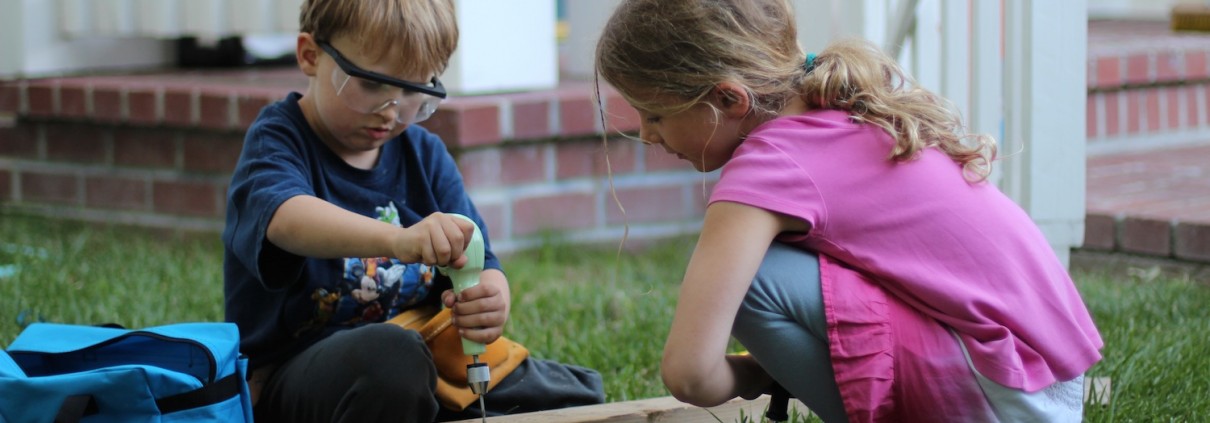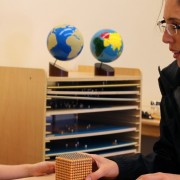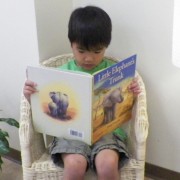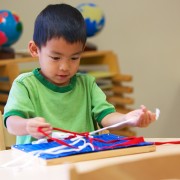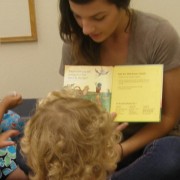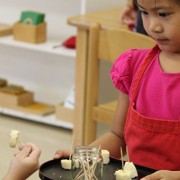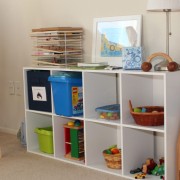To Share or Not to Share? (Part 2 of 3)
Part Two of Three: Practicing Voluntary Sharing at Home
In Part One of this blog post series, we discuss our concerns with the conventional view that sharing is an inherent virtue. We differentiated between voluntary sharing for mutual gain, and surrendering under real or implied compulsion. We suggested that adults should not pressure or even encourage children to share on demand, but should instead protect their right to uninterrupted play. In our view, this approach encourages children to view other children as potential playmates, rather than threats, and results in an attitude of genuine goodwill and benevolence towards others.
In Part Two of this article, we detail how such an approach can be put in practice at home, while Part Three outlines our approach at school. Part Three also elaborates on an important additional benefit of protecting uninterrupted play, namely, the ability of the child to enter the deep concentration necessary for meaningful learning.
Practicing Voluntary Sharing at Home and Out in the World
Sharing often comes up at home with siblings, during playdates, or at playgrounds, when two children desire to play with the same toy, at the same time. Often, the children fight and then appeal to an adult to be the arbiter of their disputes. Unfortunately, whatever decision the adult makes during the arbitration, usually at least one child feels hurt and resentful of the other.

As Montessorians, we know that the best way to solve this problem is to not let it come up in the first place! We believe that the solution comes from carefully considering the challenge of sharing ahead of time, and then carefully preparing the environment—physical and human—to set everyone up for success.
Here are some principles we encourage you to consider as you prepare yourself and your home for this parenting challenge:
 Be clear on your goal: do you want to encourage voluntary sharing (trading value for value), or do you want to compel children to surrender their toys on demand? Our suggestions in this blog post focus on fostering voluntary interactions to mutual benefit. We want to help children see each other benevolently, to treat one another with respect, and to respect the rights of each child to their things and personal space. If your goals are different, you’ll want to think about different rules than those we outline here.
Be clear on your goal: do you want to encourage voluntary sharing (trading value for value), or do you want to compel children to surrender their toys on demand? Our suggestions in this blog post focus on fostering voluntary interactions to mutual benefit. We want to help children see each other benevolently, to treat one another with respect, and to respect the rights of each child to their things and personal space. If your goals are different, you’ll want to think about different rules than those we outline here.- Clearly differentiate between personal property and community toys. In a home, (just like at school) there are many things that don’t have one clear owner. Instead, many items are family or community property—from books we all can read, to the common arts and crafts supplies, from blocks to balls. Other items belong to one specific person—mom’s iPad, one child’s cuddly animal, another child’s set of hot wheel cars. To foster peaceful interactions, it’s helpful to clearly differentiate between these two categories of things. Here are some ideas to implement this at home:
- Set up clear, separate places for both categories of items. In my house, each of my two children has a cabinet in the family room that holds their personal property. Family toys are stored on a different set of open shelves.
- Be clear when new items enter the home on which category they belong: this cuddly animal is a personal possession; that set of blocks—although received as a birthday gift by one child—is to be used by all children in turn. Often, this clarity is more important than the shelf placement in avoiding fights!
 For community toys, support taking long turns. Taking long turns means that when a child is playing with an item, it is his until he is all done with it. Adults don’t impose and enforce time limits. Instead, you set up rules in advance on turn taking. Here’s how this can work out in practice, modeling after the approach we use in our Montessori classrooms:
For community toys, support taking long turns. Taking long turns means that when a child is playing with an item, it is his until he is all done with it. Adults don’t impose and enforce time limits. Instead, you set up rules in advance on turn taking. Here’s how this can work out in practice, modeling after the approach we use in our Montessori classrooms:
- A child may only play with one community toy at a time. He can take the toy from the shelf, and he needs to return it to the shelf when he is done. No hoarding! (A side benefit of this rule is that it encourages regular mid-play clean-up and prevents messes of toys on the floor or table!)
- Designate a specific place for the child to put the community toy while he is playing with it. In my house, we used work rugs of different colors for each child when my children were young. I ensured my one-year-old son stayed away from the things my three-year-old daughter had on her pink rug, and encouraged him to put his things on his blue rug. Low tables also work well as designated play spaces.
- Support long turns. This means not setting time limits (“Max, you have five minutes, then it’s Suzie’s turn”). It also means allowing big work to extend beyond normal transition times when possible—e.g., by placing a name card on an unfinished puzzle, instead of requiring it to be put away at bed time.
- For personal property, respect a child’s right to dispose of it as he wishes. Never require a child to share a personal item—but also don’t allow insensitive taunting and other rude behavior either.
- Put personal, non-shared items away before friends visit. If your son isn’t ready to share his brand-new truck, then don’t have it in the playroom when friends come over. Instead, put it away in his bedroom or a closet ahead of time. Discuss what should be out and what should be put away before visits: if your child is bought in to the idea that things in the playroom are community toys for the duration of the play date, he’s much less likely to grab a toy away from a visiting child!
- Don’t leave personal, non-sharable items lying around unattended in public places. Often, fights on playgrounds break out when one child leaves a bucket or other item unattended, and another child begins playing with it. In our family, the rule is that if you bring personal property to the park, you may keep it until you are done with it. If you leave it lying around, you signal that it’s ok if others take it. If you prefer others not take it, then you need to put it back in your bag, or bring it to a parent for safekeeping.
 Protect your child’s rights when needed; otherwise, sportscast rather than becoming an arbiter. Empower children to self-enforce clear rules you set up in advance—and to identify and articulate the emotions they experience in their encounters with each other.
Protect your child’s rights when needed; otherwise, sportscast rather than becoming an arbiter. Empower children to self-enforce clear rules you set up in advance—and to identify and articulate the emotions they experience in their encounters with each other.
- Equally support a child’s option to say yes or no when another child wants to join their play or take a toy. This can be hard, when you really would like to see your children play together! It’s tempting to try to guide, to say, “Suzie, I see Max really would like to play with you”, or to ask, “Suzie, could you please share with Max.” Because of the implied moral judgment, and the risk that the child will comply just to please you, it’s much better to instead just sportscast your observations and explain the choices: “Suzie, I see Max would like to join you in playing with the blocks. You may say yes or no, it’s your choice.”
- Protect your child’s turns and property against insensitive takers. If another child tries to grabs your child’s toy against her wishes, politely but firmly protect your child. “Max, Suzie wasn’t done with that yet. She said no when you asked for a turn. I’m going to give this back to Suzie. You may have a turn when Suzie is all done.”
- Help each child identify and articulate their own and the other child’s emotion—without pressuring either child to change their actions. This can be hard when you are faced with one or two children who have unpleasant emotions! But it’s really important: by giving children words to express their emotions, you help them learn to introspect into their own emotional states, and to view others as sentient human beings, too. Say things like, “Max, I see you are very upset that you may not have the truck right now. It’s hard to wait, isn’t it?” or “Suzie, I see Max really would like to have this toy. When you are all done, I think Max would be happy if you could find him and let him know that the truck is back in the toy box and ready for his turn.”
- Explain your house rules to other children and adults who visit. Different people have different approaches to the topic of sharing. It’s usually better to explain your rules ahead of time, rather than try to intervene when conflicts have already started!
- Explain to your children that other families may have different rules, or that other rules may apply in public places. Especially as children get older, and go to play in other homes, or are out of your constant direct supervision on a playground, it’s good to counsel them on being observant of others’ different expectations. For instance, while extremely long turns may be ok at home, it’s impolite to hog the swing at the park for a whole afternoon. So just tell your child ahead of time that at the park, we have limited times on certain pieces of equipment, when others are waiting—because that’s the considerate, polite thing to do in a shared, public space.
Being very clear on these rules is important as you set up your prepared environment. When children are very young the clarity of the rules makes it much easier for them to accept and comply. Clarity is also important with older children, if this is a change in how you approach sharing in your home.
As children internalize these implicit ideas—community property, long turns, personal property—you’ll find that things work much more naturally. Now that my children are five and seven and we have lived these ideas for a few years, we aren’t as strict about the one toy at a time rule, for example, nor do they need the rugs to designate who is playing with what. They’ve just internalized the need to respect each other’s space and property. (I would, however, bring these rules back if fighting over toys became an issue!)
Often, children—especially when they get older, say four and up—like to play together with the same toys, and that’s totally fine: recently, at a playground, my four-year-old happily shared one of his trucks with a boy we didn’t know. My son explained to him, “You can have one of my two trucks because it’s more fun to play together with someone!” Just make sure that the playing together is voluntary: it should always be ok for one child to say no if another one wants to join her play and she isn’t ready to play together just then.
Some parents may be worried about children becoming self-absorbed and oblivious to the needs of others if they aren’t compelled to share early on. Experience in hundreds of Montessori schools, and from many families’ personal experience shows that precisely the opposite is true. Children whose right to play uninterrupted is protected, who don’t need to constantly defend themselves from others who threaten take their things, are better able to relate to other children, to learn true empathy and to practice kindness and respect towards each other.
 In my family, we have been playing by these rules since my daughter was not quite three, and my son, not quite one: my children have never been compelled to surrender their toys on demand—not at home, not at the playground and not at their Montessori school. Yet they are both very caring, kind, friendly children—children who are quite adept at reading social clues, who can (usually) wait their turn, who speak up for their needs, and who have good relationships with their classmates and strong friendships for their age. Last summer, when we were on an extended play date with my daughter and four other six-year-old girls, one of my daughter’s friends hadn’t brought her bike along. This girl was walking alone as the other four girls were riding along happily on their bikes. After a short while, my daughter—who knew I would never ask her to share her bike—noticed her friend’s sad face and realized the friend felt left out. She got off her bike, took of her helmet, and invited her friend to take a turn.
In my family, we have been playing by these rules since my daughter was not quite three, and my son, not quite one: my children have never been compelled to surrender their toys on demand—not at home, not at the playground and not at their Montessori school. Yet they are both very caring, kind, friendly children—children who are quite adept at reading social clues, who can (usually) wait their turn, who speak up for their needs, and who have good relationships with their classmates and strong friendships for their age. Last summer, when we were on an extended play date with my daughter and four other six-year-old girls, one of my daughter’s friends hadn’t brought her bike along. This girl was walking alone as the other four girls were riding along happily on their bikes. After a short while, my daughter—who knew I would never ask her to share her bike—noticed her friend’s sad face and realized the friend felt left out. She got off her bike, took of her helmet, and invited her friend to take a turn.
This is true empathy and benevolence—it is voluntary sharing based on personal values rather a compulsory surrender of those same values. As Montessori educators, we are convinced it grows from respecting children’s right to uninterrupted play, not from adult-enforced or even adult-endorsed acts of sharing.
Why not give this approach a try with your child?

